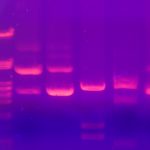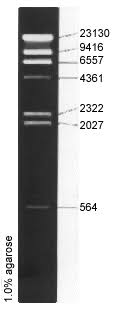DNA Fingerprinting – In Person
Scroll below for In Person Lab unit
Read along in your lab handout with the information in this webpage. Fill in and answer all questions accordingly in the handout. This handout will be collected and graded later.
Lab handout for DNA Fingerprinting – In-Person for Spring 2023
Important Background Information to review:
An Introduction to the Human Genome – Basic Structure and Variation in Human DNA (5:32)
Polymerase Chain Reaction (PCR)(opens in new window) – click on video – used to make larger samples of DNA from an initial small sample of DNA.
PCR Animation(opens in new window) – a nice simple step by step animation to show how PCR works.
Restriction Enzymes and how they are used with DNA and Restriction Enzyme animation
DNA Fingerprinting using PCR to isolate and amplify Short Tandem Repeats (STR) in small DNA samples. (4:09)
How DNA Electrophoresis works – more in depth on the electrophoretic process.
DNA Gel with labeled known DNA fragment sizes/DNA Ladder/Marker DNA (lane 1). This also shows the different banding pattern results (different sized fragments) produced when using different restriction enzymes on the same DNA.
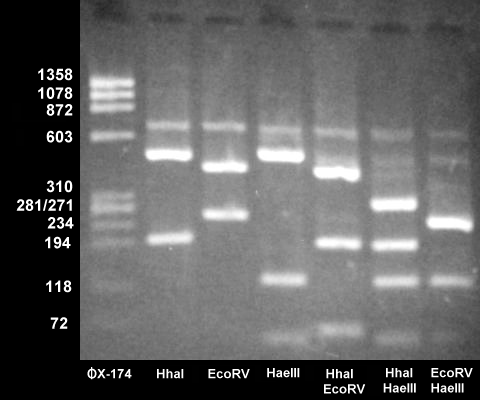
DNA Electrophoresis Equipment:
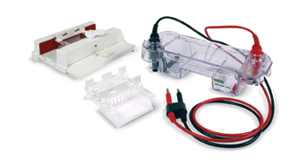
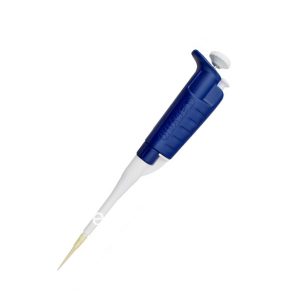
Activity 1; Practice Pipetting – short videoclips
Activity 2: Restriction Digestion of DNA – view the background Information animations above. The DNA Kit used this semester provides DNA that is already pre-digested, but it is still important to understand how restriction enzymes work and their importance in DNA electrophoresis.
Activity 3 & 4: Preparation of the 0.8% Agarose Gel and Electrophoresis Unit and Preparing the DNA Samples and Loading the Gel
In Activity Three, calculate and record the amount of agarose needed to make the indicated 0.8% agarose gels.
Casting an Agarose Gel – we will actually use a casting stand instead of tape to seal the gel tray.
DNA Electrophoresis Procedure – loading and running an agarose gel (as you will do in lab with the same equipment).
Staining Agarose Gels with Fast Blast Blue – In our teaching labs, we will use a non-toxic Fast Blast Blue stain that will bind to the DNA in the gels allowing us to visualize the bands of DNA.
Activity 5: Analyzing the DNA Patterns edit
- In our lab we will look at the pattern and location of the Crime Scene DNA on the gel and look to see which of the suspects match the same pattern for all the bands.
- Sketch and label the lanes/samples in your stained DNA gel. Include this sketch in your lab handout. Answer all the end of lab Discussion Questions #1-5 in your lab handout based upon your stained gel.
- We can look more closely at the size of sample DNA bands/fragments by comparing the distance traveled in the gel to the known base pair size of the fragments found in the known DNA Standards/Marker DNA. How many bands of the DNA Marker can you see in your own gel?
* depending on how long a gel is run, you may or may not see all the bands separate.
How DNA Electrophoresis is used in forensics – Nice new webpage – topics include: Can DNA Demand a Verdict? How can DNA be used to identify an individual? Forensic DNA Analysis. Is DNA Analysis alone enough to acquit or convict?
Activity to be run during the down time of lab: Who Stole the Crown Jewels? – This is a paper simulation that clearly demonstrates how restriction enzymes work and how DNA fragments separate out during DNA electrophoresis. (Carry out this simulations and add completed pages 4-6 to your DNA lab handout)
To reduce printing – you should read this activity online. We will provide each student with a paper copy of the gel (page 4) and the un-cut DNA sequences (page 5) and the Final Report (page 6).*
- From this handout you will need to “add” the restriction enzyme to cut the long DNA sequences for each of the DNA samples. This Restriction enzyme will find sequences CCGG and cut between the C and G as shown in the example.
- Then count and label the # of base pair (bp) in each of the new DNA fragments.
- Sketch where these fragment will end up on the DNA gel diagram.
- Examine your completed paper gel and complete page 6 in the Crown Jewels handout. Who Stole the Crown Jewels? How do you know this?
- Be sure to include the completed pages 4, 5 and 6 with your DNA Unit handouts.
* If you find you need a paper copy of the whole activity, we can print a few copies per lab section. Here you will need to cut the provided paper DNA Samples with a restriction enzyme at the set sequences of base pair units using actual scissors. Then you will tape these DNA fragments/pieces on a paper gel diagram according to the base pair size of each fragment.
Basic DNA Structure
Molecular Visualization of DNA – do not worry if you have not covered all of these topics in lecture yet. The animation will be helpful when you do review this material.
0-1:48 = DNA Structure — Also seen in the Mitosis and Meiosis lab (this part is important for lab this week)
The rest of this video with be taught later in lecture and be more applicable in the Transformation lab.
1:48-2:53 = DNA Replication –Can you relate this to DNA synthesis? = S phase that you leaned about in the Mitosis and Meiosis in lecture
2:53-4:48 = Transcription – (you will learn about this and Translation later in lecture)
4:48-6:57 = Translation –
6:58-7:47 = Hemoglobin and Sickle Cell Anemia -not narrated
DNA Presentations will be presented live in lab using PowerPoint or Google Slides June 15 in Lab.
To practice your presentations skills, each group of students will receive a DNA Topic and Target Audience to present to the class. These presentations should run 5-10 minutes. Each individual will need to speak and be equal partners in the presentation. All presentations will be recorded so that a self assessment can be done by each students of their own presentation skills. See the links below for more information. This will help you better organize and present your Group Review Paper Presentations the final week of labs.
Each student will use the Peer Evaluation form provided below to evaluate themselves and each person in their group. Submit this on Moodle by the start of the lab the week of your presentation.
DNA Presentation Expectations and Self Assessment – 30 points total
DNA Presentation TA Evaluation Sheet
Peer Evaluation form for the DNA Presentation
Important Technologies in Molecular Biology
Polymerase Chain Reaction (PCR) – used to make larger samples of DNA from an initial small amount of sample.
PCR Animation – a nice simple step by step animation to show how PCR works.
Early ideas and Development of PCR – A Not So Simple Idea
Genome Editing with CRISPR-Cas9 a new and powerful technology with many applications.
Gene Editing Tool CRISPER Wins the Chemistry Nobel (2020)
ELISA Anitbody tests – animation that shows the different steps involved in ELISA testing for the presence of antibodies.
Careers in Biotech – nice website. Careers at the Bench and Beyond
Short Reads:
The History of Genetic Fingerprinting
DNA Fingerprinting is Everywhere -discusses some applications.
NCSU Researchers Irish Potato Famine Pathogen Stoked Outbreaks on 6 Continents – using a more specialized electrophoretic genotyping
DNA “Fingerprint” Can Aid Food Safety – NCSU researcher
